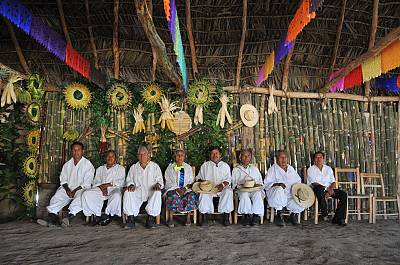- Mexico


Totonaca Indigenous Arts Centre in Mexico

© Cumbre Tajin, 2009
1. ICH domains
Oral traditions and expressions, performing arts, social practices, rituals, knowledge and practices concerning nature and the universe, traditional craftsmanship
2. Short description
The Totonac people reside in the Mexican states of Veracruz, Puebla, and Hidalgo. The Totonac Centre for Indigenous Arts (CAI) is a training centre in indigenous culture located in Veracruz. Its teachers and students come from different parts of the Totonacapan region, which includes more than 50 communities. The centre offers training in different artistic disciplines, organized in a variety of educational spaces called ‘house-schools’, each specialising in one of the Totonac arts: pottery, textiles and embroidery, traditional music, dance and rituals, the production of natural dyes and paint, traditional medicine, performing arts, and traditional gastronomy, among others. The house-schools embrace creative practice as something intrinsically linked to the spiritual nature of the Totonac people. The centre proposes cultural regeneration, revitalizing Totonac cultural practices through, for example, use of Totonac as the language of instruction, the recovery of forgotten traditional techniques, artistic production, reestablishment of traditional governing bodies and reforestation of plants and trees needed for cultural practice. Thus, in addition to learning the techniques of different artistic and social disciplines, participants acquire fundamental values of being Totonac through creative practice. The CAI was selected in 2012 on the Register of Good Safeguarding Practices.
Further information:
Links providing further information about CAI, its contribution to good safeguarding practices and video presentations of the centre:
https://ich.unesco.org/en/BSP/xtaxkgakget-makgkaxtlawana-the-centre-for-indigenous-arts-and-its-contribution-to-safeguarding-the-intangible-cultural-heritage-of-the-totonac-people-of-veracruz-mexico-00666
https://www.youtube.com/watch?v=8s_OHHT1_JY
https://www.youtube.com/watch?v=xQtdcdx8NMg (in Spanish)
https://www.facebook.com/CentrodelasArtesIndigenas/
3. Link with sustainable development
Training at the Totonac CAI focuses on the essence of being Totonac. In addition to artistic techniques, life and its creation are fundamental aspects of the teaching, connecting the two sources of community life: spiritual and material. The most valuable educational resources are consequently nature and the cosmos; the different elements that interact to strengthen and develop art. A holistic training approach links artistic practices and their sacred meanings, in turn connected to rituals and ceremonies that are very much alive in the educational process. Each of the CAI’s house-schools fosters a sustainable and healthy relationship between artistic and human practices and the environment. For example, in the textile techniques house-school, participants begin the educational process by planting cotton, caring for the crop, harvesting, preparing to turn the cotton into line and, only then, learning the textile techniques. In the painting house-school, trainees begin with the production of paint, which may involve growing specific plants or working with minerals that provide pigment; only then do they learn painting techniques. For the Totonac, building a healthy environment is a reflection of a healthy society, both in relation to itself and the available resources. Sustainability is itself thus a basic condition for maintaining the community, echoing SDG 4 on providing quality education and SDG 12 on ensuring sustainable consumption and production patterns.
4. Questions for reflection
This example demonstrates how the transmission of distinct cultural values, expressions and belief systems of the Totonac people can be supported through a holistic approach of ‘house-schools’ in the Totonac CAI.
How can the integration of intangible cultural heritage in education contribute to sustainable development?
Do you know of any similar education experiences in ICH that contribute to sustainable development in your region?
What are some of the challenges for the communities involved?